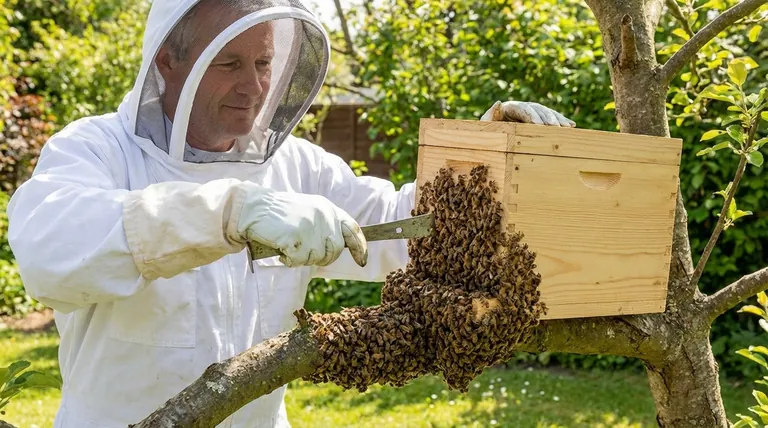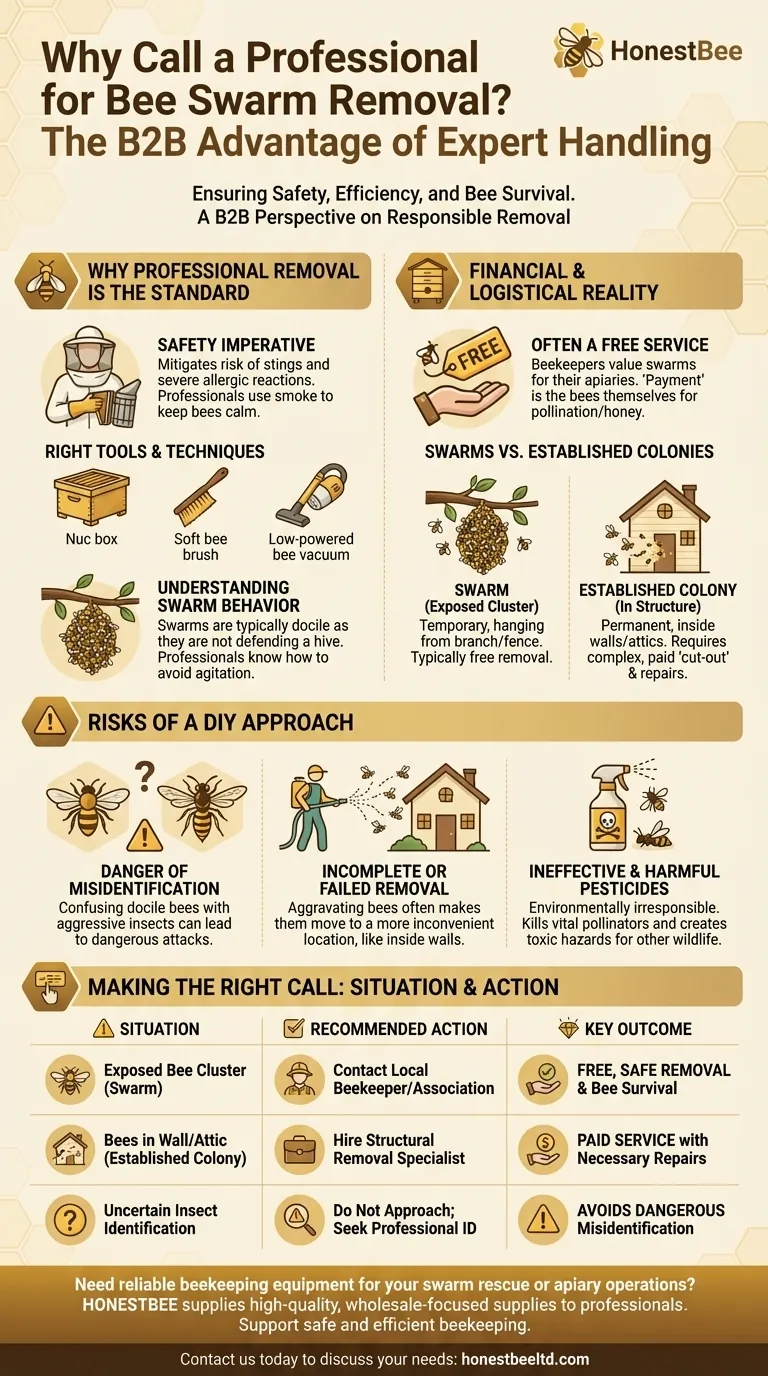When faced with a bee swarm, the primary advantage of calling a professional removalist is ensuring safety, efficiency, and the bees' survival. Professionals possess the experience and specialized equipment to handle the swarm without agitation or harm. This service is often provided for free by local beekeepers who want to give the homeless colony a new hive.
The core decision is not simply about avoiding stings, but about recognizing a bee swarm as a valuable and vulnerable natural phenomenon. A professional removalist acts as a rescuer, not an exterminator, ensuring the safe relocation of these essential pollinators.

Why Professional Removal is the Standard
Handling a swarm of thousands of bees is an intimidating task that carries inherent risks. A professional approach mitigates these risks and leads to a better outcome for both you and the bees.
Understanding Swarm Behavior
A honey bee swarm is not an aggressive nest. It is a temporary resting point for a colony that has split, with the old queen and thousands of workers searching for a new, permanent home.
Because they are not defending a hive, honey, or young, swarming bees are typically at their most docile. However, this calm state can change quickly if they feel threatened.
The Safety Imperative
The most obvious risk of a DIY removal is being stung. While a single bee sting is painful, provoking an entire swarm can lead to dozens or hundreds of stings, which can be medically dangerous.
Individuals may also discover a severe allergy to bee venom only after being stung multiple times. A professional wears a full bee suit and uses specific techniques, like applying smoke, to keep the bees calm throughout the process.
The Right Tools for the Job
A professional beekeeper arrives with specialized equipment designed for safe capture. This can include a "nuc box" to house the bees, a soft bee brush, and sometimes a low-powered bee vacuum.
Their primary goal is to locate and capture the queen. Once the queen is safely in the capture box, the rest of the worker bees will follow her scent and march into the box on their own, creating a calm and orderly removal.
The Financial and Logistical Reality
Beyond safety, there are practical reasons that make professional removal the most logical choice. It is often faster, more effective, and surprisingly, more economical.
Why is it Often Free?
Beekeepers value swarms. For them, a swarm is a free, healthy, and productive colony that they can add to their apiary for honey production or pollination services.
The beekeeper's "payment" is the bees themselves. Because of this, most local beekeepers and beekeeping associations maintain a list of volunteers who will happily come and collect a swarm at no charge to you.
Swarms vs. Established Colonies
It is critical to distinguish between a swarm and an established colony. A swarm is an exposed cluster of bees hanging from a branch, fence, or other object. This is what beekeepers typically collect for free.
An established colony is one that has already moved into a structure, such as the wall of a house, a chimney, or an attic. Removing bees from a structure is a far more complex and labor-intensive process known as a "cut-out," which involves deconstruction and repair and always comes with a significant cost.
Understanding the Trade-offs: The Risks of a DIY Approach
Attempting to handle a swarm without proper knowledge can quickly turn a simple situation into a dangerous and more expensive problem.
Danger of Misidentification
Many people confuse docile honey bee swarms with far more aggressive insects like yellow jackets, hornets, or wasps. Attempting to "capture" a nest of yellow jackets using swarm removal techniques is extremely dangerous and will result in an aggressive attack.
Incomplete or Failed Removal
If you try to spray a swarm with a hose or knock it down with a stick, you will not solve the problem. You will agitate the bees, making them defensive, and likely cause them to move to a more inconvenient location on your property—like inside your walls.
Ineffectiveness and Harm of Pesticides
Using pesticides on a honey bee swarm is the worst possible option. It is environmentally irresponsible, killing thousands of vital pollinators. It also creates a toxic mess of dead bees and poisoned honey, which can harm other wildlife that may feed on it.
Making the Right Call
To ensure the best outcome, identify your situation and contact the appropriate expert.
- If you see an exposed cluster of bees hanging from a tree or fence: This is a swarm. Contact your local beekeeping association or search for a "bee swarm removal" service. The removal should be quick and is almost always free.
- If you see bees flying in and out of a hole in your home's wall, roof, or chimney: This is an established colony. You need a specialist in structural bee removal who performs "cut-outs." This is a paid service that requires construction expertise.
- If you are unsure what kind of insect it is: Do not approach it. Take a photo from a safe distance and send it to a beekeeper or pest control professional for identification before taking any action.
By contacting a professional, you are not just solving a problem; you are playing a crucial role in protecting a vital part of our ecosystem.
Summary Table:
| Situation | Recommended Action | Key Outcome |
|---|---|---|
| Exposed bee cluster (swarm) | Contact a local beekeeper | Free, safe removal and bee survival |
| Bees in wall/attic (established colony) | Hire a structural removal specialist | Paid service with necessary repairs |
| Uncertain insect identification | Do not approach; seek professional ID | Avoids dangerous misidentification |
Need reliable beekeeping equipment for your swarm rescue or apiary operations? HONESTBEE supplies commercial apiaries and beekeeping equipment distributors with high-quality, wholesale-focused beekeeping supplies. Whether you're a professional removalist or managing a large-scale operation, our durable equipment supports safe and efficient beekeeping. Contact us today to discuss your needs and enhance your beekeeping success!
Visual Guide

Related Products
- HONESTBEE Advanced Ergonomic Stainless Steel Hive Tool for Beekeeping
- Full Set Beekeeping Electronic Bee Venom Collector Machine Device for Bee Venom Collecting
- No Grafting Queen Rearing Kit: System for Royal Jelly Production and Queen Rearing
- Thick PVC Material Waterproof Anti-Slip Wear-Resistant Bee Work Shoes Boots for Garden Outdoor Utility
- Plastic Bee Hive Stand for Beekeeping
People Also Ask
- What is a hive tool and what are its uses? Master Your Hive Inspections with the Essential Beekeeper's Tool
- What are the features of a regular hive tool? The Essential Multi-Tool for Every Beekeeper
- Why do hive tools have a hole? Unlock the Secret to Efficient Beekeeping
- What are the basic tools for beekeeping? Essential Starter Kit for Safe & Successful Hive Management
- Why is it important to compare the progress of different hives? A Beekeeper's Key Diagnostic Tool



















